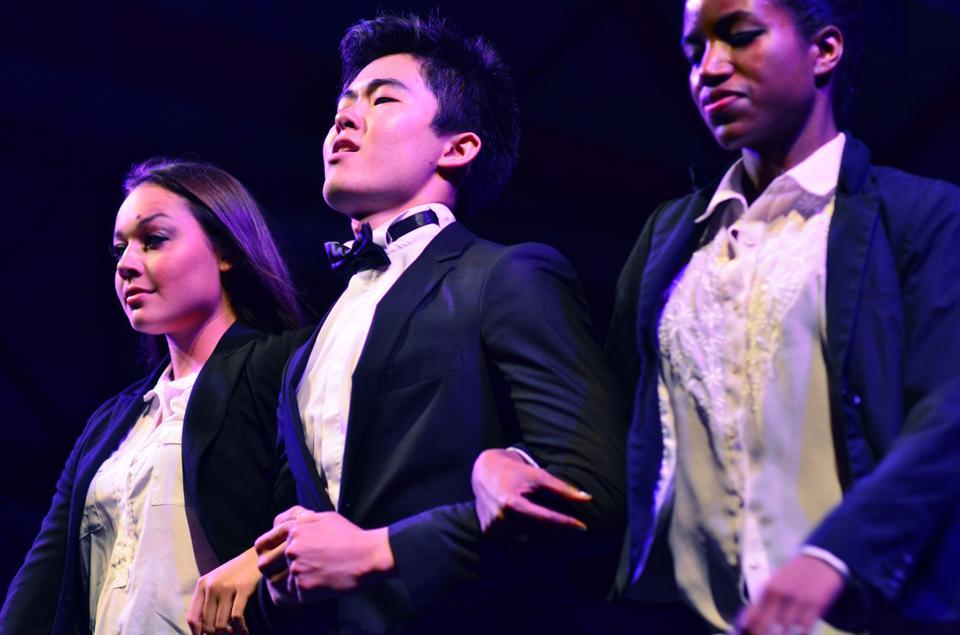
Harvard Struts the Runway
Models gyrate on stage, bodies moving in complicated circles. The sexual energy is as palpable as the throbbing bass of the hip-hop soundtrack or the audience members’ collective cloud of perfume. The models, miming a James Bond storyline, bounce down the runway. Their movements are sharp, combative. By the second act, everyone in the VIP section presses against the stage in a mass of sequins and silky hair, dancing even though they’ve been told not to. Sitting in the audience of Eleganza feels like drinking vodka-spiked, carbonated red bull.
The largest, oldest, and perhaps most renowned fashion show on Harvard’s campus, Eleganza has long been known for its glamorous ethos. Yet Eleganza’s mission, according to its website, is “focused on diversity and charity, celebrating different cultures, backgrounds, and forms of expression.” It donates its proceeds to Teen Empowerment, a Boston-based program seeking to empower youths to address social issues in their communities.
Founded in 1994 under the umbrella organization Harvard Black C.A.S.T., a student theater group dedicated to the performing arts of the black diaspora, Eleganza is a high-budget and highly-organized production. Its roots in a cultural and arts organization are still apparent, however, in the ethnic diversity of its models and highly theatrical style of its performance—an aesthetic which has gained the show both criticism and accolades over the years.
“It’s a spectacle,” says Thomas M. Dai ’14, who worked as a fashion director for Eleganza his freshman year, and has since been heavily involved in the Harvard fashion scene. “Confident, definitely sexy, definitely in a way provocative—that sort of theatrical element to it,” he says.
In past years, this element of provocation has sometimes led to controversy, largely surrounding the show’s portrayals of racialized and sexualized beauty. As early as 1998, reported The Crimson, some students were criticizing the overt sexuality of the performance, alleging that Eleganza’s sexy aesthetic objectified female models. Back in 2004, an advisor for the Association of Black Harvard Women sent an open letter over an email list wherein she criticized the production for what she believed to be its stereotypical portrayal of African Americans. In 2009, a Crimson editorial writer lodged another complaint: Eleganza had not fulfilled its professed charity obligation. Last year, the alleged photoshopping of models’ bodies in posters sparked discussion over what some saw as the disparity between the show’s mission and its practices in terms of the promotion of diverse beauty standards. This year, the show’s official Facebook features a notice under one of its promotional albums alluding to that controversy. The disclaimer reads, “Note: Eleganza does NOT photoshop the bodies of its models. They’re naturally this beautiful.”
But for students like Dai, it’s not the history of controversy or even the clothing that truly marks Eleganza, but its fast-paced glitz. “It’s a night where people can dress up, people can have fun,” he says. “It does have this sort of Social Network-y feeling. ‘Oh, we’re going to go out and see these beautiful people on the runway.’” Yet, says Dai, the show goes far beyond Harvard prep.
For Macarena M. Arias ’14, who modelled in Eleganza for the first time this year, working on the show helped break some of these stereotypes. “I think there is this expectation, the stereotype that final clubs have: white, rich, whatever. But I definitely see diversity when it comes to that, in terms of ethnicity,” Arias says. Arias, who lives in the Dudley Co-op and modelled in menswear, says that she tried out on a whim. When Arias modeled, she swaggered across the stage along with the other menswear models, posed and added a pelvic-thrust at the end.
One side of Arias’s hair is shorn to her scalp, the other wavy to her chin. She indicates her own look as proof of the diversity of models in the show. “I’m not a model. I never try to wear preppy,” says Arias. “And I’m in it.”
While it is a fashion show, Eleganza’s main draw is not necessarily the clothes. “Anyone can tell going to the show that the clothes are not the stars,” says Meisha B. Brooks ’14, a professional model who has worked on the production end of Eleganza in the past and who is familiar with Harvard’s fashion scene. “What makes Eleganza so attractive is that it is more for everyone, everyone can enjoy it and be entertained by it.”
As models strut to the thrum of the music and the roar of the crowd, it’s easy to see why, for students like Dai, Eleganza is, at heart, a fantasy. It’s “escapist,” he says. “With these fashion shows, there’s the impulse to give a different world."


